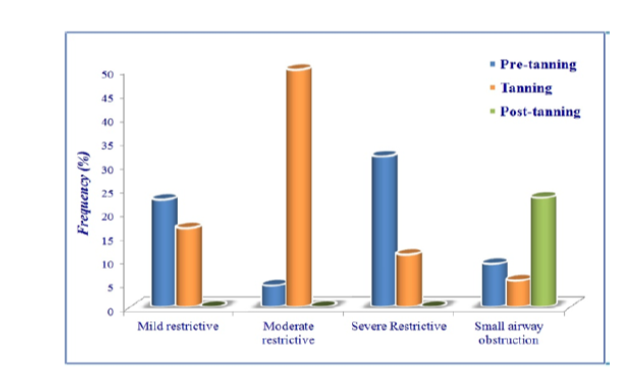


Indian Journal of Science and Technology
Year: 2021, Volume: 14, Issue: 4, Pages: 382-392
Original Article
Panjakumar Karunamoorthy1, Embiranahalli Mani Rajesh2, Beerappa Ravichandran1*, Dhananjayan Venugopal1, Karthik Gunasekaran3, Hariharan Naina4, Mala Ambikapathy1
1Industrial Hygiene & Toxicology, ICMR-Regional Occupational Health Centre (Southern), Kannamangala PO, Devanahalli Taluk, Bangalore, 562110, India. Tel.: 09483525382
2Department of Microbiology, PSG College of Arts and Science, Civil Aerodrome, Coimbatore, 641014, India
3Department of Community Medicine, Christian Medical College, Vellore, 632004, India
4Factory Medical Officer, Asian Paints, Kanchipuram, 602105, India
*Corresponding Author
Tel: 09483525382
Email: [email protected]
Received Date:22 October 2020, Accepted Date:01 January 2021, Published Date:05 February 2021
Background/Objectives: Tannery workers are prone to lung diseases due tohazardous operational conditions. Therefore, the present study was designed to investigate the respiratory morbidities and lung infections among tanneryworkers. Methods: This study included 110 tannery workers (83 male and 27 female). Pulmonary Function Test (PFT) was carried out among 53 workers. Direct microscopic examination and standard microbial culture were carried out to identify lung infections from clinical samples. Statistical analyses were carried using the SPSS software, version 26. Findings: Pulmonary Function Test (PFT) revealed severe restrictive, moderate restrictive and small airway obstruction among 16.9%, 18.9% and 11.3% of workers respectively. PPE usage was reported among 68% of the workers. Only 3.6% of the subjects reported being used face masks during work. The respiratory symptoms viz; cold & cough (44.5%), asthma (2.7%), wheezing (14.5%), shortness of breath (17.3%) and chronic bronchitis (3.6%) were noted among study subjects. A significant association was found between altered PFT values and the risk factors such as working sections and lack of PPE usage (p<0.05). Bacterial lung infections viz; Klebsiella pneumonia, Streptococcus pneumonia, Staphylococcus aureus and fungal infections viz; Candida albicans, Aspergillus niger and Aspergillus flavus were identified. Confounding factors of working sections and lack of PPE usage found to influence the PFT parameters. Applications: The study highlights the constant infectious hazards at the workplace. Frequent health monitoring, workplace monitoring, engineering controls and PPE use are mandate to curtail respiratory morbidity among tannery workers
Keywords: Tannery workers; occupational lung disorder; Pulmonary function test; lung infections
© 2021 Karunamoorthy et al.This is an open access article distributed under the terms of the Creative Commons Attribution License, which permits unrestricted use, distribution, and reproduction in any medium, provided the original author and source are credited. Published By Indian Society for Education and Environment (iSee)
Subscribe now for latest articles and news.